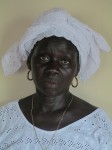
Sabel Jatta used to harvest oysters for six months of the year in The Gambia’s Tanbi Wetlands National Park. Today, harvesting season lasts just four months, and that has not been easy for Sabel or her fellow women harvesters. The shorter season means oysters are not available to sell during the high-demand, peak tourist season from October to February. And that means less income for the women during the holiday season when household expenses are high.
Even so, Sabel is happy about the change. She and her fellow oyster harvesters are the ones who decided to shorten the season. Earning a living from oyster harvesting was getting more and more difficult: It was taking the women longer to collect fewer oysters; the oysters were getting smaller, bringing a lower price; and conflicts were increasing with other users of the mangroves where the oysters grow. The women understood that continuing their practices would mean continuing these negative trends.
Over the last four years, with help from the USAID/BaNafaa Project implemented by the Coastal Resources Center of The University of Rhode Island’s Graduate School of Oceanography, Sabel and fellow members of the TRY Oyster Women’s Association have come together to share what they know about the oysters and the mangrove ecosystems. The project worked with the women to combine their local knowledge with scientific knowledge. The women’s action research increased their understanding of the resource, boosted their confidence to take new approaches and gave them results that were accessible to them for informed decision-making.
With their developing strength as a unified body, TRY Association members proposed sustainable management measures for the oyster and cockle fishery in the Tanbi Wetlands. Measures include establishing the eight-month seasonal closure to maximize spawning and growth, creating a minimum size limit for harvested oysters and using tools that remove oysters from mangroves without damaging the roots. Their work led to a Cockle and Oyster Co-Management Plan approved by the Government of The Gambia that gives the TRY Association exclusive use rights to the fishery in the 6,300 hectare Tanbi Wetlands National Park, an internationally recognized RAMSAR site. It may be the first time a national government in Africa has granted such rights to a women’s association.
Two years later, Sabel still struggles to support her family, but for her and the other women in the TRY Association, the user rights granted in the Co-Management Plan have brought tangible and positive results. They have actively practiced the measures agreed to in the plan and have respected the closed season from July to February. USAID/BaNafaa Project activities also have helped the women by improving their opportunities for income during the off season. Literacy training, a micro-finance savings and loan program and training on processing, marketing and preserving oysters are just some examples. User rights have also enabled TRY Association communities to enforce the closed season and fine violators. Penalty fees have been collected and retained by the TRY Association community where the violation occurred.
Most importantly, two years have been long enough for Sabel and the other women to see that by waiting longer to harvest the oysters, they grow bigger and gain market value. Prices have doubled over the two-year period to about $0.70 – $0.80 cents/cup. Also, customers have noticed the adoption of hygienic practices that the women learned in project-sponsored trainings. These include wearing gloves, caps and smocks when processing and selling oysters and placing the product up off the ground covered with nets to keep out flies. These improvements contribute to the consumer’s willingness to buy TRY Association oysters at a fair price.
Healthy oysters that grow large and plentiful depend on a healthy and plentiful mangrove ecosystem. The TRY Association women see the positive impacts of their actions and are confident that they will benefit from their efforts. Being highly motivated to protect and expand the volume and health of the mangroves, the women are willing to make an immediate investment of time and effort for a benefit that will be realized in the longer term. With USAID and other donor assistance, the women have planted more than 33 hectares of new mangroves in the last two years. Their harvest tools and the extended closed season have reduced mangrove destruction. The power they have gained to educate and bring visibility to those who are cutting or destroying mangroves has helped to make mangrove protection more of a reality than merely a law on paper.


